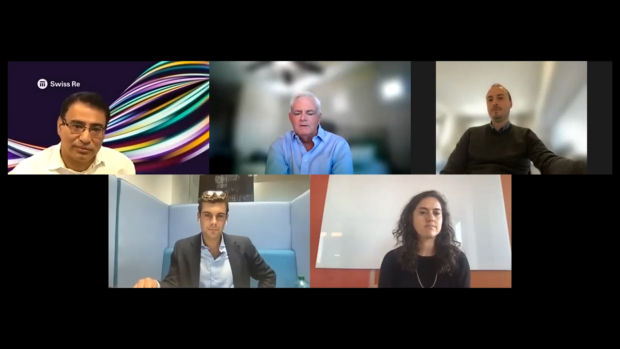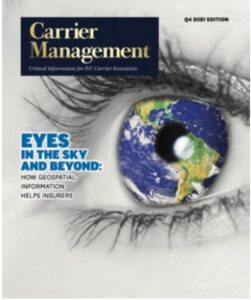Last month, Carrier Management Guest Editor and CB Insights Analyst Mike Fitzgerald hosted a roundtable bringing together participants in the world of geospatial information systems, seeking to understand reasons behind the increased interest in applying imagery data to existing and emerging insurance problems.
During the roundtable (video accessible above), representatives of a commercial insurer, a global reinsurer, a flood mapping specialist and an MGA creating specialty parametric insurance products describe a confluence of technology developments that are making satellite imagery more accessible to insurers of all sizes, environmental concerns that are fueling demand, as well as some remaining obstacles to broad-based acceptance by insurance underwriters.

Panelists are (starting at top, left to right):
- Pranav Pasricha, Global Head P&C Solutions, Swiss Re
- Moderator Mike Fitzgerald, Principal Analyst, Insurance, CB Insights
- Giacomo Favaron, Senior Specialist, Insurance Pricing, AXA XL
- James Rendell, Chief Executive Officer, BirdsEyeView Technologies Ltd.
- Bessie Schwarz, CEO and Co-Founder, Cloud to Street
Listen for these key takeaways:
[1.23] Fitzgerald: A definition of geospatial information systems.
[4.11] Rendell: What is BirdsEyeView Technologies? How can underwriters use Earth observation data to create new insurance products for the SME sector? (Hint: parametric coverage.)
[5.34 ] Pasricha: Swiss Re’s InsurTech. What Swiss Re P&C Solutions does in GIS and other areas.
[7.50] Schwarz: Introducing Cloud to Street. Analyzing flood risk without ground equipment.
[9.05] Schwarz: The cover of Nature magazine. Cloud to Street uncovers 86 million more people affected by floods than previously known.
[11.42] Schwarz: Why now? Why the insurance industry’s love of satellite technology is starting to blossom and go deeper into the market. (Hint: AI and the cloud.)
[15.33] Favaron: Satellite launches are getting cheap. “Before the advent of reusable rockets, the average cost per kilo per launch was about $9,000-$10,000. Now, it’s $1,400-$1,500 per kilo.”
[16.39] Fitzgerald: Uber, Lyft and SpaceX Rideshare.
[18.30] Favaron: Seeing through clouds—going from three spectral bands that humans can see to more than 20.
[22.57] Favaron: Putting data together. “From the point of view of the insurer, it is really amazing that we are in an age where we can see or predict natural events, but still we need to know on the ground who owns what, when that building was built, will it withstand a particular natural event like a storm…”
[24.07] Schwarz: Users need answers. “Our users on the ground…don’t actually care about the millions of pixels we’re crunching all the time or the cool new algorithm that we just published on it. They don’t even want the map…They want just the answer to their question, which is often just a CSV table of their assets and which ones are flooded today and not.”
[28.35] Rendell: What underwriters need. Seeing a car on the road is cool—and great for claims and damage assessments, but not underwriting. “What’s fundamental to insurance is you can’t escape from the fact that you still need to do the risk modeling.”
[31.07] Rendell: What makes underwriters nervous. “All underwriters ever ask [is], ‘How much historical data have you got and how consistent is it?’ Yes, you can do some fantastic correlations between the historical data and the live data, but it just leads to twitchy feet and being uncomfortable.”
[34.49] Schwarz: Satellite data for business interruption? “One thing I’m really excited about is developing out more robust business interruption insurance products… I feel pretty strongly that the widespread disruption from climate change that’s coming over the next years, decades…is just going to disrupt economies really on all scales, to orders of magnitude potentially beyond what we’ve just seen in the last two years.”
[37.52] Favaron: Environmental insurance applications. “Some satellite products can be used as proxy for human or animal activities, which might be of interest, for example, to livestock, or to the environmental line of business—for what type of pollutants are generated from a production plant, which might give you an idea of what kind of production they have there, how much storage they have and these types of things.”
[40.29] Pasricha: Keys to success with GIS. “My view is, first of all, it starts with the mindset. And again, I’ll speak for us at Swiss Re, I think we’ve always prided ourselves on being that standard bearer for innovation and progress in the industry.”
[40.50] Pasricha: Motivation at Swiss Re. “We believe in climate change. We want to take affirmative action. We want to be a part of the action on climate change. We want to close the protection gap and make the world more resilient.”
[41.20] Pasricha: Partnerships are key. “You can’t do everything yourself. You shouldn’t, and you can’t.
[47.43] Rendell: How providers can help insurers. “Not every underwriter or insurance company is like Swiss Re, [which] has a Research Institute and every bright young person coming out of a Swiss university. I think you need to be able to give it to them on a plate. It might be as basic as giving them an Excel file and saying, ‘We’ve got this data; you should be pricing it like this.'”
[49.13] Schwarz: The Future. “We really need to expand our idea, or even our concept of what insurance is as we start to face more risks going forward.”
[49.53] Schwarz: A scientist’s view of insurance. “Insurance is the coolest thing ever.”
[51.00] Schwarz: What it’s all about. “Keeping the most vulnerable people at the center of what we’re doing here.”
 A more comprehensive article about the video roundtable, “Seeing Through Clouds: Why Now Is the Time for Geospatial Technology in Insurance,” and additional articles about geospatial information systems are available in Carrier Management’s Q4 2021 edition “Eyes in the Sky and Beyond.“
A more comprehensive article about the video roundtable, “Seeing Through Clouds: Why Now Is the Time for Geospatial Technology in Insurance,” and additional articles about geospatial information systems are available in Carrier Management’s Q4 2021 edition “Eyes in the Sky and Beyond.“
Click here for a free PDF copy.
To be able to read and share individual articles more easily, consider becoming a Carrier Management member to unlock everything.




















 Nearly Half of 100 Largest P/C Insurers Destroy Value: ACORD
Nearly Half of 100 Largest P/C Insurers Destroy Value: ACORD  Artificial Intelligence Is Rewriting the Rules for Commercial Lines
Artificial Intelligence Is Rewriting the Rules for Commercial Lines  Slideshow: Carrier Management’s 2025 Top Editor’s Picks (Unlocked)
Slideshow: Carrier Management’s 2025 Top Editor’s Picks (Unlocked)  Breaking: Andersen to Replace Zaffino as CEO of AIG on June 1
Breaking: Andersen to Replace Zaffino as CEO of AIG on June 1 